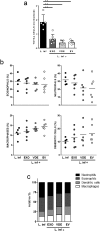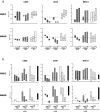More than just exosomes: distinct Leishmania infantum extracellular products potentiate the establishment of infection
- PMID: 30455859
- PMCID: PMC6237156
- DOI: 10.1080/20013078.2018.1541708
More than just exosomes: distinct Leishmania infantum extracellular products potentiate the establishment of infection
Abstract
The use of secretion pathways for effector molecule delivery by microorganisms is a trademark of pathogenesis. Leishmania extracellular vesicles (EVs) were shown to have significant immunomodulatory potential. Still, they will act in conjunction with other released parasite-derived products that might modify the EVs effects. Notwithstanding, the immunomodulatory properties of these non-vesicular components and their influence in the infectious process remains unknown. To address this, we explored both in vitro and in vivo the immunomodulatory potential of promastigotes extracellular material (EXO), obtained as a whole or separated in two different fractions: EVs or vesicle depleted EXO (VDE). Using an air pouch model, we observed that EVs and VDE induced a dose-dependent cell recruitment profile different from the one obtained with parasites, attracting significantly fewer neutrophils and more dendritic cells (DCs). Additionally, when we co-inoculated parasites with extracellular products a drop in cell recruitment was observed. Moreover, in vitro, while VDE (but not EVs) downregulated the expression of DCs and macrophages activation markers, both products were able to diminish the responsiveness of these cells to LPS. Finally, the presence of Leishmania infantum extracellular products in the inoculum promoted a dose-dependent infection potentiation in vivo, highlighting their relevance for the infectious process. In conclusion, our data demonstrate that EVs are not the only relevant players among the parasite exogenous products. This, together with the dose-dependency observed, opens new avenues to the comprehension of Leishmania infectious process. The approach presented here should be exploited to revisit existing data and considered for future studies in other infection models.
Keywords: Leishmania; air pouch; dendritic cells; exosomes; extracellular vesicles; immunomodulation; infection; macrophages.
Figures





Similar articles
-
Extracellular Vesicles Released by Leishmania (Leishmania) amazonensis Promote Disease Progression and Induce the Production of Different Cytokines in Macrophages and B-1 Cells.Front Microbiol. 2018 Dec 21;9:3056. doi: 10.3389/fmicb.2018.03056. eCollection 2018. Front Microbiol. 2018. PMID: 30627118 Free PMC article.
-
Extracellular Vesicles Released by Leishmania (Leishmania) amazonensis Promastigotes with Distinct Virulence Profile Differently Modulate the Macrophage Functions.Microorganisms. 2023 Dec 13;11(12):2973. doi: 10.3390/microorganisms11122973. Microorganisms. 2023. PMID: 38138117 Free PMC article.
-
Toll-like receptor-positive cells and recognition of pathogens: how human myeloid dendritic cells respond to in vitro infection with Leishmania infantum.Curr Pharm Des. 2006;12(32):4255-62. doi: 10.2174/138161206778743556. Curr Pharm Des. 2006. PMID: 17100627
-
Modulation of Host-Pathogen Communication by Extracellular Vesicles (EVs) of the Protozoan Parasite Leishmania.Front Cell Infect Microbiol. 2019 Apr 11;9:100. doi: 10.3389/fcimb.2019.00100. eCollection 2019. Front Cell Infect Microbiol. 2019. PMID: 31032233 Free PMC article. Review.
-
Leishmania Vesicle-Depleted Exoproteome: What, Why, and How?Microorganisms. 2022 Dec 8;10(12):2435. doi: 10.3390/microorganisms10122435. Microorganisms. 2022. PMID: 36557688 Free PMC article. Review.
Cited by
-
Immunomodulatory Properties of Leishmania Extracellular Vesicles During Host-Parasite Interaction: Differential Activation of TLRs and NF-κB Translocation by Dermotropic and Viscerotropic Species.Front Cell Infect Microbiol. 2020 Jul 29;10:380. doi: 10.3389/fcimb.2020.00380. eCollection 2020. Front Cell Infect Microbiol. 2020. PMID: 32850481 Free PMC article.
-
Amphotericin B-Loaded Extracellular Vesicles Derived from Leishmania major Enhancing Cutaneous Leishmaniasis Treatment through In Vitro and In Vivo Studies.Iran J Parasitol. 2023 Oct-Dec;18(4):514-525. doi: 10.18502/ijpa.v18i4.14260. Iran J Parasitol. 2023. PMID: 38169565 Free PMC article.
-
The Use of Specific Serological Biomarkers to Detect CaniLeish Vaccination in Dogs.Front Vet Sci. 2019 Oct 24;6:373. doi: 10.3389/fvets.2019.00373. eCollection 2019. Front Vet Sci. 2019. PMID: 31709270 Free PMC article.
-
Eimeria falciformis secretes extracellular vesicles to modulate proinflammatory response during interaction with mouse intestinal epithelial cells.Parasit Vectors. 2022 Jul 8;15(1):245. doi: 10.1186/s13071-022-05364-x. Parasit Vectors. 2022. PMID: 35804396 Free PMC article.
-
Revisiting the Principles of Designing a Vaccine.Methods Mol Biol. 2022;2410:57-91. doi: 10.1007/978-1-0716-1884-4_3. Methods Mol Biol. 2022. PMID: 34914042
References
-
- Naderer T, McConville MJ.. Intracellular growth and pathogenesis of Leishmania parasites. Essays Biochem. 2011;51:81–15. bse0510081 [pii] PubMed PMID: 22023443; eng. - PubMed
-
- WHO Leishmaniasis, Fact sheet N°375 2014. [cited 2015 January19].
-
- Cecilio P, Oliveira F, Cordeiro-da-Silva A. Vaccines for human leishmaniasis: where do we stand and what is still missing? In: Afrin F, editor. Leishmaniases as re-emerging diseases. Rijeka: IntechOpen; 2018: 59–93.
LinkOut - more resources
Full Text Sources
Other Literature Sources

